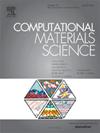基于短程有序的高熵合金超快速大尺度建模
IF 3.3
3区 材料科学
Q2 MATERIALS SCIENCE, MULTIDISCIPLINARY
引用次数: 0
摘要
高熵合金(HEAs)表现出复杂的原子相互作用,其中短程有序(SRO)在决定其性能方面起着关键作用。传统的方法,如合金理论自动化工具包(ATAT-mcsqs)中的特殊准随机结构蒙特卡罗发生器(ATAT-mcsqs),超级细胞随机近似(chips)和混合蒙特卡罗分子动力学(MC-MD),往往受到有限的系统尺寸和高计算成本的阻碍。作为回应,我们引入了PyHEA,这是一个基于python的工具包,具有高性能的c++内核,它利用全局和局部搜索算法,增量SRO计算和GPU加速来实现前所未有的效率。在构建随机HEAs时,PyHEA比at -mcsqs和scrap的速度分别提高了333,000倍和13,900倍,同时保持了较高的精度。PyHEA还提供了一个灵活的工作流程,允许用户从外部模拟(例如LAMMPS或密度泛函理论(DFT))中合并目标SRO值,从而实现更现实和可定制的HEA模型。作为概念证明,PyHEA在几分钟内成功地复制了256,000个原子的Fe-Mn-Cr-Co系统的文献结果-比混合MC-MD方法提高了一个数量级。这种显著的加速为连接理论见解和实际应用开辟了新的可能性,为下一代HEAs的高效设计铺平了道路。本文章由计算机程序翻译,如有差异,请以英文原文为准。

Short-range order based ultra fast large-scale modeling of high-entropy alloys
High-Entropy Alloys (HEAs) exhibit complex atomic interactions, with short-range order (SRO) playing a critical role in determining their properties. Traditional methods, such as Monte Carlo generator of Special Quasirandom Structures within the Alloy Theoretic Automated Toolkit (ATAT-mcsqs), Super-Cell Random APproximates (SCRAPs), and hybrid Monte Carlo-Molecular Dynamics (MC-MD)—are often hindered by limited system sizes and high computational costs. In response, we introduce PyHEA, a Python-based toolkit with a high-performance C++ core that leverages global and local search algorithms, incremental SRO computations, and GPU acceleration for unprecedented efficiency. When constructing random HEAs, PyHEA achieves speedups exceeding 333,000 and 13,900 over ATAT-mcsqs and SCRAPs, respectively, while maintaining high accuracy. PyHEA also offers a flexible workflow that allows users to incorporate target SRO values from external simulations (e.g., LAMMPS or density functional theory (DFT)), thereby enabling more realistic and customizable HEA models. As a proof of concept, PyHEA successfully replicated literature results for a 256,000-atom Fe–Mn–Cr–Co system within minutes—an order-of-magnitude improvement over hybrid MC-MD approaches. This dramatic acceleration opens new possibilities for bridging theoretical insights and practical applications, paving the way for the efficient design of next-generation HEAs.
求助全文
通过发布文献求助,成功后即可免费获取论文全文。
去求助
来源期刊

Computational Materials Science
工程技术-材料科学:综合
CiteScore
6.50
自引率
6.10%
发文量
665
审稿时长
26 days
期刊介绍:
The goal of Computational Materials Science is to report on results that provide new or unique insights into, or significantly expand our understanding of, the properties of materials or phenomena associated with their design, synthesis, processing, characterization, and utilization. To be relevant to the journal, the results should be applied or applicable to specific material systems that are discussed within the submission.
 求助内容:
求助内容: 应助结果提醒方式:
应助结果提醒方式:


